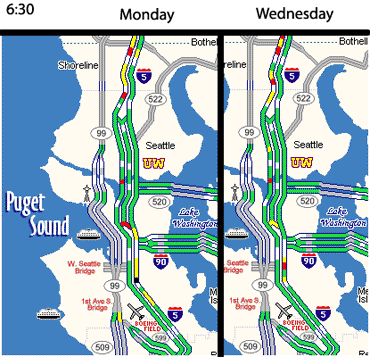During my daughters’ school year—back when my two-stop commute was particularly gnarly—I noticed what must be a familiar pattern to long-time Seattle-area I-5 commuters: traffic on Monday and Friday mornings tended to be way better than it was from Tuesday through Thursday.
In my experience, it was pretty common for the entire highway to be clogged for miles—even the carpool lanes—on Tuesday, Wednesday, and Thursday. But on a good Monday or Friday, the trip from north of Seattle straight into downtown could be a relative breeze, even for drive-alone commuters. The pattern was fairly consistent, but occasionally bad weather or a traffic accident still snarled traffic on Monday or Friday. However, last week, Seattle’s weather was pretty much the same on Monday and Wednesday—and Monday’s traffic was a snap, while Wednesday’s was a slog.
I’ve put together some animations of the two days’ morning commutes, from 6:30 to 9 a.m., using archived traffic images from the state DOT. Green means free-flowing traffic; yellow is slight congestion; red is heavy congestion; and black is when traffic has slowed to a crawl. (Check out my mad Photoshop skillz…)
For the most part, traffic on my route (leading south on I-5 into downtown) was pretty easy that Monday. There were some backups and delays at the canal bridge, and a few slowdowns here and there. But by 9:00 the traffic was pretty clear.
Not so on Wednesday—traffic started about the same at 6:30 as it had on Monday, but pretty soon it became a nightmare. At 9:00, the highway was still a parking lot.
Now, I don’t know for certain what accounts for the difference. But I think it’s pretty simple: there are just enough people who don’t work Mondays or Fridays—either because of flexible, 4×10 hour work schedules, or because of people taking long weekends or vacation days—that traffic volumes never quite reach the “tipping point” between free-flow and gridlock.
That’s how traffic tends to work: a roadway that’s operating near peak capacity—full, but flowing freely—can suddenly descend into gridlock if just a few extra cars enter the highway at once. That’s one reason that Seattle’s metered on-ramps help keep traffic moving more smoothly: by regulating access, they help prevent the sudden bursts of traffic that can bring a highway to a standstill.
Anyway, the difference between Monday and Wednesday is probably a small decrease in peak volume—maybe, what, 5 to 7 percent? anyone out there know?—that helps keep the entire system from descending into gridlock for an hour or more.
To me, that’s food for thought in the whole congestion relief debate: drivers might be better off paying to use the road, getting real congestion relief in return, than paying to build a road while getting nothing but more clogged lanes.









Matt the Engineer
I’d say it’s a clear reason to start working a 4 day week. Assuming, of course, this week starts on friday.